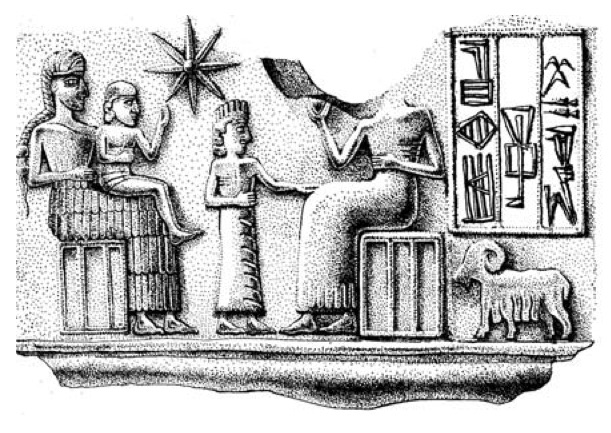Five seals belong to one of the kings of Urkesh, named Tupkish, eight belong to his queen, Uqnitum, and five more belong to courtiers connected with their household. These scenes emphasize the royal family as the figures of the family appear in them. In addition to the family scenes from the royal court are depicted, as for instance, in some scenes of the queen Uqnitum she is surrounded by her daughter and female servants while a lyre player and singer entertain them. Other kings of Urkesh have seals represented in our corpus, the latest found in the 2004 season. This new endan (the Urkesh kings identified themselves with the Hurrian title for king), takes up a theme found in the Tupkish seals of a lion at the court. In both, the lion reclines before a basin into which liquid is being poured in what appears to be a recurrent court ritual. The scene in the new endan seal is striking in that the small figure standing with the deity is not facing the deity (as in all other Akkadian seal iconography) but rather faces the ritual enactment. In other words the small figure is equated with the god! Who is this figure? Certainly a human and more than likely the endan whose seal it is!! So it appears that our new endan is equating himself with a god!!
We know that the Akkadian king, Naram-Sin, considered himself a god and from Urkesh we have door sealings of one of his daughters, Tar’am-Agade. She is more than likely in Urkesh as a queen because she has a combat scene on her seal related to the political expression of Akkadian power in the south. In the same cache as the seal impressions of Tar’am-Agade were impressions on door sealings of a Hurrian official; he too has a combat scene, only the second non-Akkadian known to be granted this privilege! Included in this cache too are impressions of an official with an Akkadian name, Ishar-beli. His scene is unique in that it shows a prancing equid before a seated deity. We do have a number of equid bones from our excavations as well as a large number of equid figurines. The presence of Naram-Sin’s daughter in the Urkesh court, probably as its queen, is evidence, we think, that he had an alliance with Urkesh. That is that he did not conquer it in the same way he conquered Ebla and Nagar (Tell Brak). Urkesh was the only major third millennium Syrian city not conquered by him, and if this is indeed the case indicates that this city had an independence not accorded to the rest.

